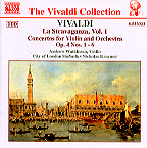To judge from the CD catalog or from concert programs and radio broadcasts, you’d think Vivaldi was a one-hit wonder of the Italian Baroque, the “Four Seasons” being his only orchestral work worthy of wide attention. Indeed, we conservatory students used to joke that Vivaldi really did only write one piece, which he simply recycled and vaguely disguised by placing it in different keys, tempos, and scorings for different instruments. Well, when your job is to write music–lots of music–and among your 100 operas and solo cantatas, dozens of sonatas for various instruments, and multitudes of works for choir, instrumental duet, and trio, there also happen to be 550 concertos, there just may be instances where you reuse some material.
Fortunately, Vivaldi happened to be a very good composer with an abundant supply of melodic ideas, and was very adept at forging these into works that kept soloists busy and audiences thoroughly engaged. The music is almost invariably upbeat, with lots of lively allegros, and none of the concertos lasts more than 10 minutes. The collection of 12 concertos known as La Stravaganza was published in two volumes a year or so after Vivaldi’s more famous Op. 3 set, L’estro armonico, and while the La Stravaganza concertos don’t attain Op. 3’s inventive heights, there are many dazzling moments and movements, which are fully exploited by the virtuoso solo playing of violinist Andrew Watkinson and his able and dynamic ensemble partners.
Conductor Nicholas Kraemer generally manages to keep everything tight and trim, but there are passages where attacks aren’t collectively precise–nothing at all disastrous, but it’s noticeable because of the high level of unity everywhere else. The hard-edged sound, which seems a function of the primary recording location at London’s All Saints Church (the A major concerto receives more agreeable treatment in the ideal acoustics of Rosslyn Chapel), unfortunately detracts from these stylish performances, which for now remain the La Stravaganza of choice, for the catalog offers scant competition.
































